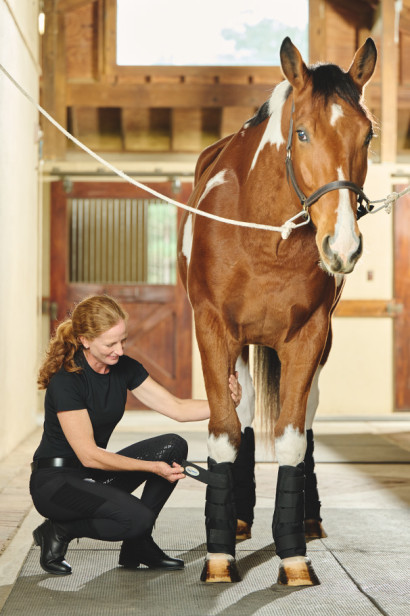Equine Therapy Programs: Transforming Lives One Ride at once
Equine Therapy Programs: Transforming Lives One Ride at once
Blog Article
Reviewing the Efficiency of Laser Therapy in Equine Therapy for Injury Rehab
The evaluation of laser therapy's effectiveness in equine injury rehab pivots on numerous variables, including healing time, pain reduction, and tissue regrowth. Vets often observe remarkable end results with laser treatment compared to traditional methods, positioning it as an important aspect in equine care.
Understanding Laser Treatment
Laser treatment has ended up being a critical tool in vet medication, especially in the treatment of equine problems. Understood for its non-invasive nature and effectiveness, laser therapy involves the application of details wavelengths of light to promote tissue repair and reduce swelling. This healing technique is progressively preferred for its capability to accelerate the recovery procedure in horses struggling with a selection of bone and joint injuries and chronic conditions.
The primary device behind laser therapy is its capacity to enhance mobile functions. When laser light passes through the skin, it is absorbed by mitochondria, the giant of cells, which causes increased manufacturing of adenosine triphosphate (ATP) This biochemical energy increase assists in cellular repair service and regeneration. In addition, laser therapy advertises vasodilation, improving blood circulation and oxygen delivery to broken cells, thus accelerating recovery.
In equine medication, laser treatment is particularly useful for problems such as tendonitis, osteo arthritis, and injury healing. The method is lauded for its pain-relieving residential or commercial properties, enabling steeds to reclaim mobility and function a lot more swiftly. Vets also appreciate its very little negative effects contrasted to various other therapy methods, making it a reputable and risk-free alternative for equine treatment.

Just How Laser Treatment Works

Upon absorption, these photons activate a series of biochemical changes, enhancing mitochondrial feature and bring about raised adenosine triphosphate (ATP) manufacturing. This increase in ATP speeds up mobile metabolism, promoting cells fixing and regrowth. Furthermore, laser therapy modulates inflammatory feedbacks by influencing cytokine levels and reducing oxidative stress and anxiety, consequently easing pain and swelling.
An additional substantial element of laser treatment is its function in enhancing microcirculation. The treatment advertises vasodilation, enhancing blood flow and oxygen delivery to damaged tissues (Equine Therapy). This promotes the removal of cellular particles and sustains the proliferation of fibroblasts and collagen synthesis, critical for wound recovery
Medical Proof
The effectiveness of laser therapy in equine therapy has been corroborated with different professional research studies, showcasing its therapeutic possible throughout a variety of problems. Numerous controlled tests and observational research studies have documented substantial renovations in tissue repair, pain reduction, and general recovery timelines. A research study carried out by Turner et al. (2012) demonstrated that horses treated with low-level laser therapy (LLLT) for tendon injuries exhibited sped up recovery compared to those getting traditional therapies. The research highlighted a marked decrease in swelling and boosted collagen formation.
Likewise, study by Johnson and colleagues (2015) focused on equine muscular tissue injuries, revealing that laser therapy dramatically expedited muscle fiber regrowth and lowered muscular tissue rigidity. Scientific analyses have actually shown that laser treatment can relieve chronic conditions such as Click Here osteoarthritis.
Vet Insights

Vets also value the flexibility of laser therapy. It can be utilized for a variety of problems, from superficial wounds to deeper bone and joint injuries. Dr. Emily Brown highlights its energy in treating conditions like tendonitis and osteoarthritis, where standard therapies frequently fail. She explains that laser therapy can be tailored to the details demands of each horse, guaranteeing optimal outcomes.
Moreover, veterinarians value the capability to integrate laser treatment with various other therapy modalities. This multimodal technique can enhance general treatment effectiveness, giving a detailed remedy for equine recovery. Such endorsements from skilled specialists emphasize the expanding acceptance and application of laser treatment in equine medicine.
Practical Factors To Consider
A key facet of carrying out laser therapy in equine therapy involves understanding the practical considerations that ensure its effectiveness and safety. It is vital to pick the suitable laser device, as various kinds differ in wavelength, power, and infiltration depth. Vets have to be fluent in these parameters to customize treatment visit their website protocols efficiently to every injury kind
Furthermore, the regularity and duration of laser therapy sessions require mindful preparation to take full advantage of restorative benefits while decreasing any kind of possible unfavorable impacts. Consistent monitoring of the equine's reaction to therapy can guide needed modifications in the treatment routine. Establishing a risk-free and controlled setting throughout treatments is also important to protect against unintentional exposure to laser emissions, view website which might hurt both the equine and the trainer.
Educating and certification of workers carrying out laser treatment are vital to make sure proper method and to maintain safety and security requirements. Additionally, maintaining exact records of each session, including laser setups and observed results, is vital for assessing the general effectiveness of the treatment and for making data-driven choices.
Final Thought
Laser treatment has emerged as a reliable method in equine injury recovery, supplying considerable advantages in healing time, discomfort alleviation, and tissue recovery. For optimum results, constant surveillance and individualized therapy procedures remain crucial in leveraging the complete potential of laser treatment in equine treatment.
Report this page